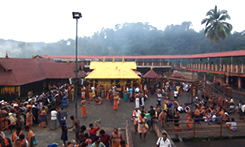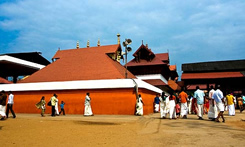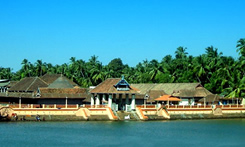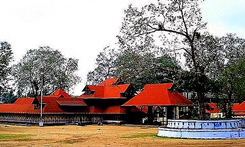Places Of Worship
The Kerala Pilgrimage Destinations are an excellent illustration of secular co-existence and religious harmony. There are several pilgrimage destinations all over Kerala, India that cater to the spiritual needs of people belonging to different faiths be it Hindus, Muslims, Christians or any other faith. Pilgrims come all over India for pilgrimage tours to the several pilgrimage destinations located in Kerala, South India.
Sabarimala

Swamiye! Saranamayyappa! This cry called from the guts of the Sabarimala pilgrims echoes the Sahyadri mountain ranges (Western Ghats) where Sabarimala shrine is located. The temple which is intricately woven into the myth of Kerala' formation from the axe of Parasurama attracts millions of believers every year during Makara masam (Malayalam month of Makara). After restraining from worldly pleasures for over 41 days the devotees hike 18 hills, treading the road full of sharp stones and thorns to reach the abode of the Lord. The truest at heart are sure to have a vision of Makara Vilakku or the divine lamp which lights on its own during an auspicious day.
For the curious historian, the place is of great importance as there is a perfect blend of religious harmony associated with the Sabarimala belief. According to the myth, Ayyappa's accomplice was Vavar swami who is believed to be a Muslim. The belief and the reverence given to Vavar by the pilgrims reveal the coexistence of the two cultures - Haindava and Islamic) in the history of Gods Own Country.
The temple is located in Pathanamthitta district. The easiest route to the temple is via Chalakkayam, by which one can reach the banks of the river Pamba by vehicle. Pamba is the main halting point on the way to Sabarimala. From here one has to trek 4 to 5 km to reach the temple.
Guruvayoor

History rests in blissful peace at the 5,000 year old Guruvayur temple, situated around 29 km north-east of Thrissur, the cultural capital of Kerala. The temple is very much a part of the state's culture through the heart wrenching poetic references to Unnikrishna in the works of literature icons like Poonthaanam and Kururamma.
The belief goes that a darshana or sight of the deity itself would bring home abundance of riches, especially `puthra janmam' (birth of the male child) to those who worship with a true heart. The temple is also known for its Melpathur, Naarayaneeyam (a praise of Lord Sri Krishna) which fills the minds of the devotees with ethereal peace. The temple and its campus which spread across
For the casual visitor of tradition and culture Guruvayur could be an interesting place to visit as it is an abode of wonders. Elephant sanctuary of the temple which gives shelter to over 51 elephants attracts many tourists to the place. The temple also gives sanctuary to over 550 cows in a 500 acre sprawling estate belonging to the Dewaswam board. And for those interested in art forms, Krishnattam, dance of Lord Krishna performed in the temple premises during dusky evenings could be a worthwhile show.
Sree Padmanabha Swami Temple

An ultimate symbol of servitude to God, Sree Padmanabha Swami Temple stands right at the heart of the state capital, Thiruvananthapuram. The temple which has a history dating back to the rule of kings of Thiruvithaamkur state perfectly summarises the Vaishnava tradition of Kerala. Historically, the Kings of the region especially King Marthandavarma had called themselves servants of the reigning deity, Lord Vishnu.
The majestic temple is known for its seven-tier Gopuram (tower) and stands by the serene lotus spring or Padma Theertham. Being an excellent specimen of artistic grandeur, it has a long, well lit corridor with 365 sculptured granite pillars and an 80 foot flag staff which stands before its main entrance. The temple was the epicentre of culture during the rule of kings and hence has its ground floor dedicated to theatre (Nataka Sala) where the traditional and majestic dance form, Kathakali is performed till date during the Malayalam months Meenam and Tulaam.
The artistry which went into the making of the idol of Lord Vishnu is also a major attraction as it depicts him lying back on serpent Anantha or Adi Sesha. The serpent has his face pointed upwards as if relishing the scent emanating from the lotus held in the deity's left hand.
Triprayar Rama Temple

Set near river Triprayar, near Thrissur district, this temple which enshrined the most powerful Rama deities of the state has a lingering silence and austerity around its setting. The temple which was once bordered by the river on all three sides still bear the watermarks of a great tradition of architecture and mythological past.
As the legend goes, the idol worshipped here belonged to Krishna another avatar of lord Vishnu. According to the legend the idol alone survived when the when Dwaraka (land of Lord Krishna) was submerged by sea. The idol was later believed to be rescued from the sea and brought to Triprayar by fishermen.
Coupled with an august architectural style, the temple is noted for its `grabhagruha' or the main hall which is square in plan and built on a massive base. The `namaskara mandapam' has a treasure of carvings on wood. Enchanting murals are found on the neatly carved interiors. Though it dates back to 11th century, the temple still casts its spiritual charm on believers and tourists. Thriprayar is only 24 km from Thrissur railway station and the nearest airport is at Nedumbasheri.
Kodungallur Bhagavathi Temple

The overwhelming power and life of a Goddess is what Kodungallur Bhagavathi Kshetram symbolises. The temple has two deities, Lord Shiva and Goddess Kaali. The two are found to be worshipped side by side being given equal importance. The prayers offered at this temple are expected help one defy one's enemies (sathru samharam).
Historically the temple is of utmost importance as it is linked to three traditions all at the same time. The Bhagavathi idol is believed to have replaced Buddhist tradition which was once existent in the state. It is also associated with the legend of Kannaki from the Tamil mythology, Shilapathikaaram. Goddess Kali of the temple is also known as Kannaki Amma in certain parts of the neighbouring state, Tamil Nadu.
And the most historically fascinating aspect of the temple is its heathen tradition which comes alive in its Bharani Uthsavam. The belief was that the goddess needs an abhishekham (offering) of swear words and hence a procession of thousands used to roam the streets mouthing the most insane foul words to satisfy the Goddess.
While most of the erstwhile traditions including animal sacrifices are done away with in this modern age, the temple with its mystic history pulls many visitors and believers to the place.






















